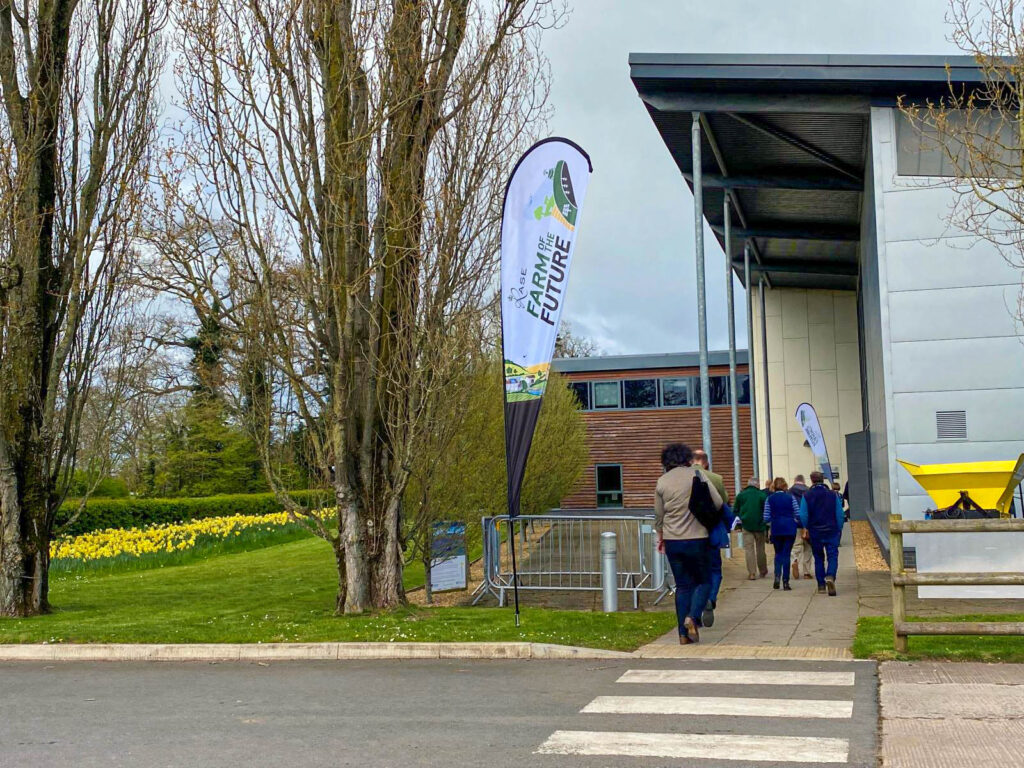Farmers share decarbonisation strategies at Farm of the Future event
21st April 2023
Speaking from personal experience, farmers shared tried-and-tested strategies for reducing emissions at the Innovation for Agriculture and Royal Agricultural Society of England’s (RASE) ‘Farm of the Future: Net Zero in Practice’ event, where improved efficiency, production of renewable energy and carbon sequestration were identified as key factors in achieving net zero in agriculture.
Delivered on behalf of RASE by Innovation for Agriculture (IfA) with support from Harper Adams University, the event took place on 13th April 2023 on the Harper Adams campus.
Amongst others, it brought to life messages from the ‘2022 Farm of the Future: Journey to Net Zero’ report, which was commissioned by RASE to identify practical steps farmers can take towards decarbonising the industry by showcasing the latest science and its on-farm application.
Speaking at the event, Helen Browning OBE, chief executive at the Soil Association, shared how she undertook a full assessment of her farm business in Wiltshire, producing organic dairy, beef, pigs and cereals.
“I looked at the nutrient balance on the farm, what was going on and what was coming off, by way of N and P especially. We also did a review of our carbon emissions and I wanted to understand what our mitigation options were as part of our ‘getting to net zero’ plan,” she added.
“The results, on the basis of what our soils were doing, along with a small area of woodland and some young agroforestry, showed that we were sequestering 70% of our emissions.”
According to Ms Browning, this still leaves over 1,000 tonnes of carbon being emitted by the farm each year. She is currently exploring natural options for methane inhibition, such as willow and herbal leys, to reduce emissions from livestock, as well as calculating the amount of woodland and hedges needed to offset emissions on the farm.
Louise Manning, poultry farmer and professor of agri-food at the Lincoln Institute for Agri-food Technology, spoke about how renewable energy can play a role in farm decarbonisation.
She believes that, given there is financial support from government, farmers will decarbonise very quickly if it works for their business model. She shared that the launch of the Renewable Heat Incentive in 2011 enabled her family farm business to increase its woodchip boiler capacity to produce just under 1MW renewable energy, which was used to heat the chicken houses.
The farm also produces 75GW of solar energy, but is currently unable to increase solar capacity due to the grid in Herefordshire being limited to take in additional energy.
“We’re totally held back by the grid capacity, to not only decarbonise further ourselves, but to support our neighbours to decarbonise too. We need to look at how to increase capacity in the grid in some areas of the country, so farmers can play a real role in producing energy and supporting national decarbonisation,” Professor Manning added.
Stacking enterprises is key to resilience
Abi Reader, farmer and deputy president at NFU Cymru, said that of all the methods of farm decarbonisation, she finds sequestering carbon the most difficult to grasp. She added the new farm support payments are currently being developed in Wales, and might potentially include the condition that all Welsh farms must have trees on 10% of land.
“As a farmer I’m looking at that and thinking how do we make this work? But we can grumble about it, or we can see if there’s an opportunity,” she pointed out.
Ms Reader sought counsel from a forester on social media, who assured her that trees should only be grown if they’re going to be useful to the farm business and if they’re going to provide an income within five years. Working together with her parents and uncle, she has now set up an agroforestry trial on a triangle-shaped field with bedrock close to the surface.
The system is comprised of a selection of tree species in rows, as short rotation coppice, which can be harvested within two to five years. The wood from the harvesting can be used to produce various low-carbon materials, such as concrete or plaster.
Between the rows of trees, Ms Reader plans to grow another crop called Sita. “It’s like a cross between a sycamore sapling and a maize plant,” she said. “It has massive leaves which are supposedly huge suckers of carbon and rhizome roots. It’s also a high protein crop which could potentially displace soya.”
Meanwhile, Stephen Briggs, arable farmer and head of technical development at IfA, also spoke about the benefits of agroforestry. Mr Briggs has introduced trees to his arable system on Bluebell Farms in Cambridgeshire, which has helped the farm make the most of available sunlight.
“A wheat crop only uses 65-68% of the available solar radiation, if we used 100% there wouldn’t be any weeds,” he pointed out.
“Nature worked this out a long time ago – it’s about different species, different times, different places to catch as much of the sunlight as possible. In our farming system we’ve chosen to stack enterprises. We’ve stacked productive fruit trees, pollen and nectar areas and crop production all in the same field.”
Through agroforestry, Bluebell Farms is now sequestering around 4.5 tonnes of carbon per hectare. Mr Briggs highlighted the system is also about 20% more productive than monoculture due to the stacking up enterprises, but is also more complex to manage.
Finally, he added farmers should strive to take control of the changes in the industry rather than letting it happen to them. “Change is constant in our industry. We’re pretty good at adapting to change, but we need to be driving that change and controlling it, rather than it being done to us.
“Part of that is benchmarking to measure where you’re starting from and moving to, also stack enterprises for resilience, harvest the opportunities available to you and only do things you enjoy,” Mr Briggs concluded.

